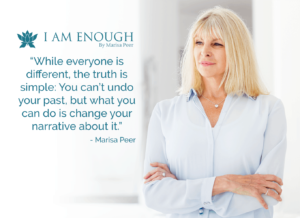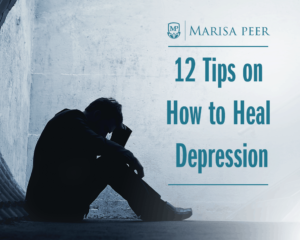Jennifer Aniston is someone who famously went through a very public breakup with Brad Pitt. This all came back up again when Brad split from Angelina Jolie and Jennifer was able to open up about how traumatic the relationship ending had been. She told Vanity Fair “It’s sad, something coming to an end. It cracks you open, in a way – cracks you open to feeling. When you try to avoid the pain it creates greater pain. I’m a human being, having a human experience in front of the world.”

We love to share real-life stories with you, to celebrate personal triumphs over adversity. In researching the PTSD in Relationships article, we came across this inspiring story by P.K. Philips, which demonstrates the power of understanding the root cause of an issue and getting help through therapy treatment to gain freedom from it. We also reflect on a very famous split and how traumatic the breakup had been..
As featured in The Anxiety and Depression Association of America’s ‘Personal Stories of Triumph’, P.K. Philips’ story features a brave young lady who found herself diagnosed with PTSD at the age of 35, following traumatic earlier life experiences. Her description of how she felt and the impact this had on her life, losing her job and career and being unable to function, really brings to life the very debilitating impact trauma can have on people’s lives.
The outside world saw a beautiful model, but inside she was struggling with PTSD
As a model, P.K.Philips appeared to “have it all.” She said “I can look back now and gently laugh at the people who thought I had the perfect life. I was young, beautiful, and talented, but unbeknownst to them, I was terrorized by an undiagnosed debilitating mental illness.” She starts her story by saying “It is a continuous challenge living with post-traumatic stress disorder (PTSD), and I’ve suffered from it for most of my life.”
Here is her story in her own words…
“Having been properly diagnosed with PTSD at age 35, I know that there is not one aspect of my life that has gone untouched by this mental illness. My PTSD was triggered by several traumas, including a childhood laced with physical, mental, and sexual abuse, as well as an attack at knifepoint that left me thinking I would die. I would never be the same after that attack. For me, there was no safe place in the world, not even my home. I went to the police and filed a report. Rape counselors came to see me while I was in the hospital, but I declined their help, convinced that I didn’t need it. This would be the most damaging decision of my life.
For months after the attack, I couldn’t close my eyes without envisioning the face of my attacker. I suffered horrific flashbacks and nightmares. For four years after the attack, I was unable to sleep alone in my house. I obsessively checked windows, doors, and locks. By age 17, I’d suffered my first panic attack. Soon I became unable to leave my apartment for weeks at a time, ending my modeling career abruptly. This just became a way of life. Years passed when I had few or no symptoms at all, and I led what I thought was a fairly normal life, just thinking I had a “panic problem.”
Then another traumatic event re-triggered the PTSD. It was as if the past had evaporated, and I was back in the place of my attack, only now I had uncontrollable thoughts of someone entering my house and harming my daughter. I saw violent images every time I closed my eyes. I lost all ability to concentrate or even complete simple tasks. Normally social, I stopped trying to make friends or get involved in my community. I often felt disoriented, forgetting where, or who, I was. I would panic on the freeway and became unable to drive, again ending a career. I felt as if I had completely lost my mind. For a time, I managed to keep it together on the outside, but then I became unable to leave my house again.
Around this time I was diagnosed with PTSD. I cannot express to you the enormous relief I felt when I discovered my condition was real and treatable. I felt safe for the first time in 32 years. Taking medication and undergoing behavioral therapy marked the turning point in my regaining control of my life. I’m rebuilding a satisfying career as an artist, and I am enjoying my life. The world is new to me and not limited by the restrictive vision of anxiety. It amazes me to think back to what my life was like only a year ago, and just how far I’ve come.
For me there is no cure, no final healing. But there are things I can do to ensure that I never have to suffer as I did before being diagnosed with PTSD. I’m no longer at the mercy of my disorder and I would not be here today had I not had the proper diagnosis and treatment. The most important thing to know is that it’s never too late to seek help.” Thank you, P.K. Philips, for bravely sharing your story, we are pleased to hear that you got the treatment that helped and hope this helps inspire others to do the same.
As globally-renowned therapist Marisa Peer says in her book ‘I Am Enough’, “While everyone is different, the truth is simple: You can’t undo your past, but what you can do is change your narrative about it.
Once you’ve located the issues that are underpinning your behaviors, it’s time to change how you frame or feel about those issues. The only person who can do that is you.
We are here for such a short time, and I truly believe that life is an immense gift. I have watched clients, readers, and followers of mine from all over the world change their lives in an instant. How? Because they changed their thoughts and beliefs. No matter who you are or what you’ve gone through, you have the power to change your thoughts and beliefs, too.”
The inspiring truth that can change your life
Whilst we cannot change what has happened to us, we are empowered to change how we respond and the meaning we attach to it, therefore changing the impact it has on our life. This is an empowering truth that we can all use to get our mind working with us and not against us.
In her Rules of the Mind article, Marisa says “every thought you think causes a physical reaction and an emotional response within you. First, you make your beliefs and then your beliefs make you.”
This article on How To Heal Depression reflects on how 1 in 4 of us will experience mental health issues this year!
“Despite how common mental health issues are, people still feel stigmatised, alone or unsure of what to do to help.
Your understanding, attitude and willingness to have a conversation around mental health could quite literally change someone’s life. Everyone needs to know that there is hope and there is help.
A Time to Change survey showed that 60% of people with mental health problems waited over a year to tell the people closest to them. Their research shows that up to 90% of people with mental health problems feel some form of stigma, from friends and family, at work, in education or during treatment. It shouldn’t be this way.
Organisations such as Mind and Rethink Mental Illness provide more information, support, and advice. Mind also provides additional resources on what is a mental health problem, so you can feel more confident in your understanding around mental health and having a meaningful conversation when it matters most.”
Help is available
As Jennifer Aniston said in her Vanity Fair interview ”Am I lonely? Yes. Am I upset? Yes. Am I confused? Yes. Do I have my days when I’ve thrown a little pity party for myself? Absolutely. But I’m also doing really well… I believe in therapy; I think it’s an incredible tool in educating the self on the self. I feel very strong. I’m really proud of how I’ve conducted myself.”
Jennifer Aniston wanted to make the point that “I’m not comparing my suffering to other people’s suffering. Everybody has their own…I have a lot of compassion for everyone going through this.” She also stated “I am not defined by this relationship” and openly spoke about the power of therapy and trying to reframe the experience, looking for the positive deeper meaning. She said “I have to think there’s some reason I have called this into my life,” she says. “I have to believe that—otherwise it’s just cruel.”
Effective therapies can make such a difference
Marisa Peer explains how “One of the ways in which Rapid Transformational Therapy™ gets fast and permanent results, is that it addresses the root cause and then looks at the role, function, and purpose of the issue playing out. We learn to get our minds and bodies working for us, not against us. Our mind’s primary purpose is to try to protect us and keep us safe, to prevent us from being at risk or in danger. Our symptoms are usually our body’s way of communicating with us that something needs addressing. I always say that understanding is power and the understanding gained through Rapid Transformational Therapy™ can have the most liberating transformative power to improve lives quickly and permanently.”
In this useful article on Stress Management there are practical exercises and tips for dealing with anxiety and stress, such as:
“Self care is health care.
Relaxing activities activate the parasympathetic nervous system and your body’s natural healing state. Activities, like getting a massage or pampering yourself, are not just a luxury. Self-care should be part of your health care routine and are an important part of destressing…
Any traumatic experience can form deep-rooted beliefs that affect our behaviour on a subconscious level. Rapid Transformational Therapy helps people understand and transform the underlying issues, freeing people from any limiting beliefs, reprogramming the mind for success. Learning stress management techniques can benefit all areas of your life.”
This FREE GIFT: Perfect Relaxation self-hypnosis audio by Marisa Peer is a wonderful way to relax and achieve health from within. You can dramatically reduce stress using the power of your mind by simply listening and enjoying this free gift.











